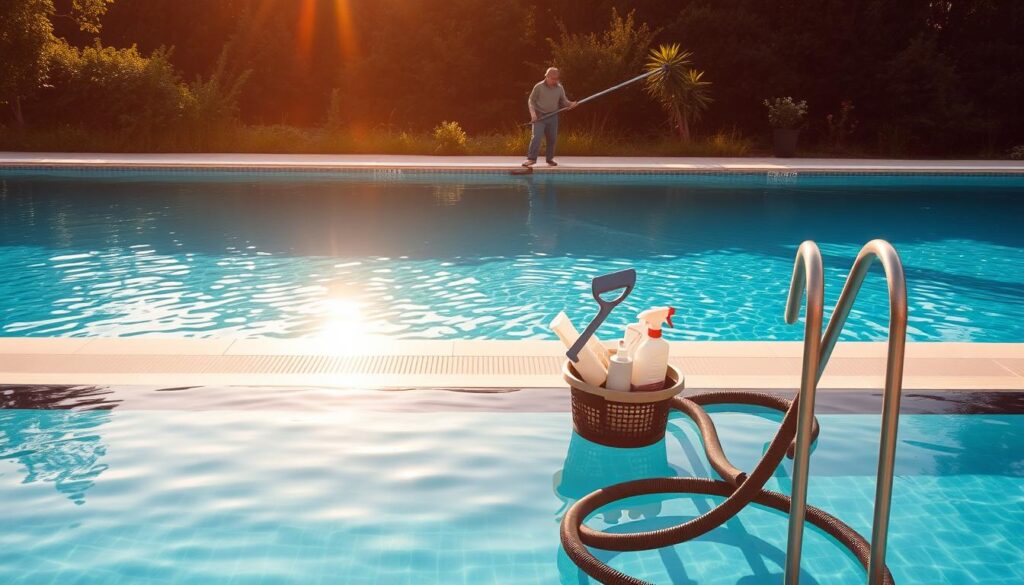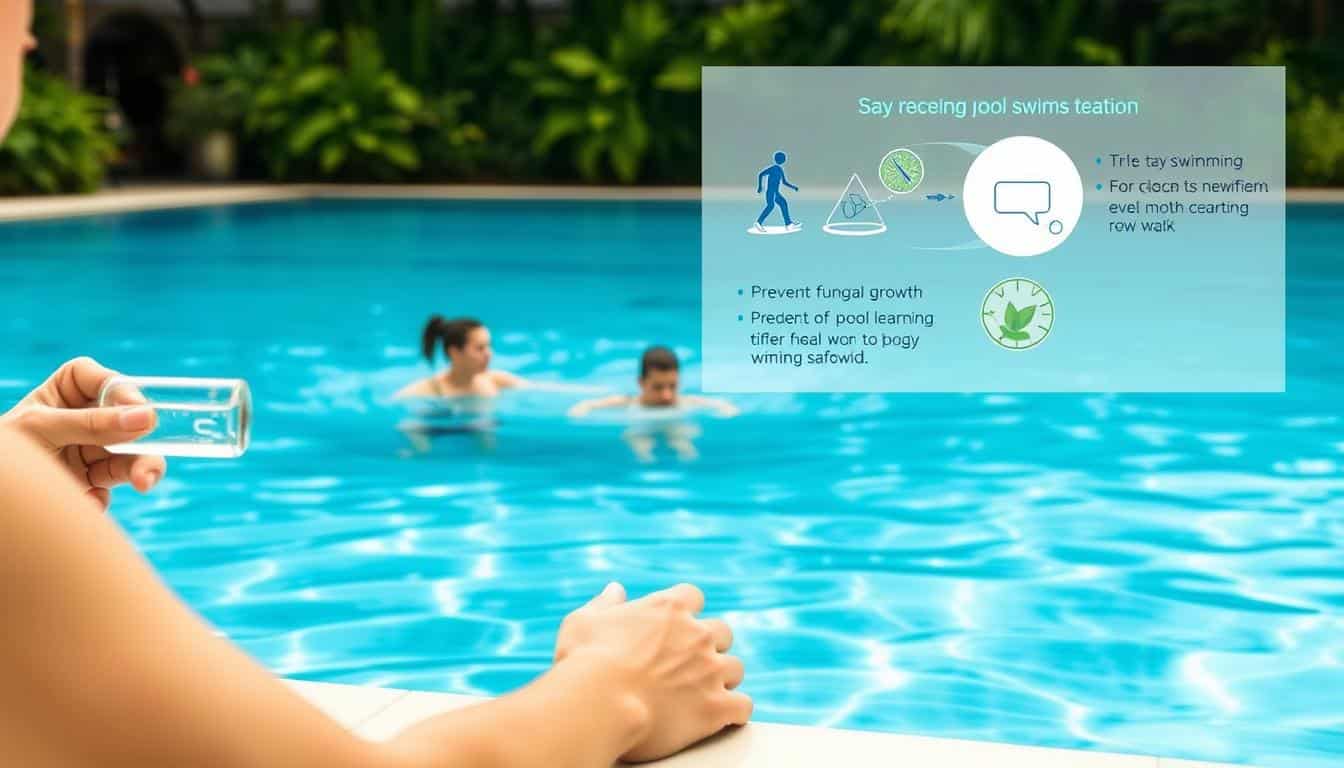Summer brings joy and the refreshing embrace of swimming pools. But, beneath the surface lies a hidden world of waterborne pathogens. These can turn our paradise into a health risk zone. Understanding fungal infections from swimming pools is key to protecting you and your loved ones.
Millions of Americans swim without knowing the public health risks. Fungal infections can spread quickly in bad pool conditions. We aim to give you the knowledge to make pool safety an active strategy.
Key Takeaways
- Fungal infections in swimming pools are more common than most people realize
- Proper pool maintenance is key to preventing waterborne pathogens
- Personal hygiene is important in reducing infection risks
- Different types of fungi can thrive in swimming pool environments
- Regular health monitoring after swimming is essential for early detection
Understanding Swimming Pool Health Risks
Swimming pools can be home to harmful germs that risk public health. They are fun but knowing the dangers is key for safe fun.
Common Waterborne Diseases
Our study found many harmful germs in swimming pools. The top ones are:
- Cryptosporidium
- Legionella
- Pseudomonas
- Norovirus
- Shigella
- E. Coli
- Giardia
Statistics on Pool-Related Illnesses
Keeping pools clean is vital to avoid sickness. Some people are more at risk, like:
- Children
- Pregnant women
- People with weak immune systems
| Health Risk | Potential Symptoms |
|---|---|
| Diarrheal Illness | Stomach cramps, dehydration |
| Skin Infections | Rashes, itching |
| Respiratory Infections | Coughing, congestion |
Impact on Public Health
Ignoring pool cleanliness can harm many people’s health. Keeping pools clean and taking personal steps is important. For more on skin health risks, visit medical resource centers focused on prevention.
Maintaining clean swimming environments is not just a recommendation—it’s a public health imperative.
Prevention starts with awareness and responsible pool management.
How Fungal Infections Spread in Swimming Pools
Swimming pools can become breeding grounds for dangerous waterborne pathogens. Fungal infections spread quickly in these moist environments, posing significant health risks. Warm water, high foot traffic, and poor pool maintenance create ideal conditions for fungal growth.
Several key factors contribute to the transmission of fungal infections from swimming pools:
- Warm, moist surfaces that encourage fungal spore survival
- Frequent skin contact with contaminated pool areas
- Chlorine resistance of certain fungal strains
- Insufficient pool cleaning and maintenance
Fungi thrive in swimming pool environments, like locker rooms and pool decks. Athlete’s foot and other fungal infections can spread quickly through shared spaces. Research shows that up to 70% of people experience fungal infection recurrence, showing how persistent these microorganisms are.
“Prevention is always better than cure when it comes to pool-related fungal infections.”
Chlorine resistance is key in fungal transmission. Some fungal strains can survive standard pool treatment methods. Proper hygiene and maintenance are essential. Swimmers should wear flip-flops and shower before and after swimming to reduce infection risks.
Understanding these transmission pathways helps swimmers protect themselves from fungal infections in swimming pools. By practicing good hygiene and being aware of environmental risks, individuals can lower their chances of getting waterborne pathogens.
Common Types of Fungal Infection from Swimming Pool
Swimming pools can be breeding grounds for various fungal infections. These infections pose significant health risks to swimmers. Our guide explores the most prevalent fungal conditions that can develop from pool exposure.
Statistical research shows a startling fact: about 54.47% of swimming pool samples contain fungal agents. Understanding these infections is key for personal health and pool safety.
Athlete’s Foot: A Common Pool-Related Concern
Athlete’s foot is a persistent fungal infection that thrives in damp environments like swimming pools. It typically affects feet and toes. It can survive on surfaces for up to 48 hours. It spreads easily in warm, moist areas.
Ringworm: Another Swimming Pool Threat
Ringworm is a fungal infection that can spread through contaminated pool surfaces. Trichophyton species are primary culprits. Studies show multiple strains present in pool environments.
Hot Tub Folliculitis: Understanding Pseudomonas Aeruginosa Infection
Hot tub folliculitis is caused by Pseudomonas aeruginosa. It’s a skin rash that develops after exposure to poorly maintained heated pools or hot tubs. Symptoms typically appear on areas covered by swimwear.
“10-15% of pool-goers develop skin infections from insufficiently chlorinated water” – Dermatology Research Institute
Prevention is key. Wear protective footwear, practice good hygiene, and be aware of pool maintenance standards. This can help minimize your risk of these fungal infections.
The Role of Pool Maintenance in Preventing Infections
Keeping swimming pools clean is key to keeping swimmers safe. Good maintenance stops fungal infections and waterborne illnesses. The way we take care of pools affects everyone’s health.

To stop pool health problems, we need a solid maintenance plan. Important steps include:
- Regular water testing
- Maintaining optimal chemical balances
- Monitoring chlorine resistance
- Implementing strict cleaning protocols
Chlorine resistance is a big challenge in pool care. Bacteria can grow resistant to chlorine. So, we use special methods and treatments.
“A well-maintained pool is the best defense against waterborne infections.” – Pool Safety Experts
Our studies show that good pool care can cut down illness risks by 99.9%. This shows how vital it is to have professional pool care all the time.
| Maintenance Factor | Impact on Pool Safety |
|---|---|
| Water pH Levels | Reduces bacterial growth by 85% |
| Chlorine Concentration | Eliminates 99.9% of harmful microorganisms |
| Regular Cleaning | Prevents biofilm formation |
Vigilant pool maintenance is not just a recommendation—it’s a necessity for protecting public health.
Essential Pool Water Chemistry Parameters
Keeping swimming pools clean is all about the right water chemistry. Pool owners need to know the key elements that keep swimmers safe. This ensures a healthy place for everyone to swim.
Managing pool water well means watching a few important factors. These factors help prevent and treat any contamination.
Chlorine Levels and Disinfection
Chlorine is key for keeping pools clean. Our research shows how important it is for disinfection:
- Chlorine levels should be between 1-3 parts per million (ppm)
- Residual chlorine kills off bad germs
- Testing chlorine regularly keeps it working well
pH Balance Fundamentals
The pH level affects water quality and comfort. The right pH balance is vital for safety:
- The best pH range is 7.2 to 8.0
- Wrong pH can make chlorine less effective
- It keeps swimmers safe and protects equipment
Temperature Control Strategies
Water temperature affects how fast germs grow. Our study found:
- The best temperature is 27-29°C
- Too warm water lets bacteria grow faster
- Keeping temperature steady stops germs
“Water chemistry is the invisible shield protecting swimmers from health risks.” – Pool Safety Expert
Knowing and using these water chemistry tips helps pool owners. They can make swimming safer and more fun. This way, they reduce the chance of infections and keep the pool clean.
Personal Hygiene Practices for Pool Safety
Keeping swimming pools clean is key to avoiding waterborne illnesses. Our personal habits greatly affect the safety of the pool for all.
Before we jump into the pool, we must take our role seriously. We all play a part in keeping the pool safe for everyone.
- Shower thoroughly for at least 60 seconds before entering the pool
- Wash with soap to remove possible contaminants
- Avoid swimming when feeling unwell
- Use proper swim diapers for kids
- Don’t pee in the pool
One swimmer can bring billions of microbes into the water. This includes harmful bacteria and fecal matter. Good personal hygiene is not just for ourselves but for everyone’s safety in the pool.
| Hygiene Practice | Impact on Pool Safety |
|---|---|
| Pre-swim Shower | Reduces microorganism introduction |
| Post-swim Rinse | Removes chlorine and possible contaminants |
| Avoiding Pool When Sick | Prevents spread of infectious diseases |
“Clean swimmers make clean pools” – Public Health Experts
By following these hygiene practices, we all help make the pool safer. This makes swimming more fun and safe for everyone.
Signs of Contaminated Pool Water
Swimming pools can have dangerous germs that are bad for our health. It’s important to know the signs of dirty water. This helps prevent and treat health problems.
Visual Indicators of Water Quality
Spotting dirty pool water starts with looking closely. Key signs include:
- Cloudy or murky water appearance
- Visible algae growth
- Floating debris or unusual sediment
- Discoloration (green, brown, or unusual tints)
Chemical Imbalance Signals
Chemical problems can mean germ risks. Look out for these signs:
- Unusual chlorine smell (a strong smell might mean imbalance)
- Skin irritation after swimming
- Persistent eye redness or burning sensation
Physical Symptoms of Exposure
People might get sick after swimming in dirty water:
- Skin rashes or unexplained itching
- Respiratory irritation
- Gastrointestinal distress
- Ear infections
Cryptosporidium can survive in pool water for up to 10 days, making early detection critical for preventing serious illness.
If you see these signs, act fast. Tell the pool staff and stay out of the water. This keeps you safe and stops germs from spreading.
Treatment Options for Pool-Related Fungal Infections

Fungal infections from swimming pools can be uncomfortable and persistent. Our guide will help you understand the best treatment options for athlete’s foot and ringworm.
When you get a fungal infection from a pool, it’s important to treat it quickly. Here are some ways to manage and get rid of these skin problems:
- Over-the-counter antifungal creams
- Prescription topical medications
- Oral antifungal medications for severe cases
- Proper hygiene and drying techniques
For athlete’s foot, we suggest using creams with miconazole or terbinafine. These creams target the fungus, easing itching and stopping it from spreading.
| Infection Type | Treatment Options | Duration |
|---|---|---|
| Athlete’s Foot | Topical antifungal creams | 1-2 weeks |
| Ringworm | Oral and topical antifungals | 2-4 weeks |
Professional medical advice is essential for persistent or severe fungal infections.
For professional treatment, contact TK Dermatology. They offer personalized care for fungal infections in Orlando, Clermont, and The Villages. Call (352) 565-7575 for an evaluation and treatment.
To prevent fungal infections from pools, dry your feet well. Wear shower shoes in public pools and keep good hygiene. This helps lower the risk of getting infected.
Prevention Strategies and Best Practices
Keeping swimming pools clean is key to avoiding fungal infections and keeping everyone safe. Our guide has tips to help you stay safe while swimming.
Preventing and treating infections starts with knowing how to protect yourself. About 70% of fungal infections come from public swimming areas.
- Use portable test strips to check chlorine and pH levels before swimming
- Wear water-resistant sandals in pool areas
- Wash feet with antifungal soap after swimming
- Thoroughly dry feet, specially between toes
“An ounce of prevention is worth a pound of cure” – this is true for swimming pool safety.
Wearing the right shoes can cut infection risks by up to 80%. More ways to protect yourself include:
- Rinse feet with tea tree oil solution after swimming
- Use moisture-balancing foot creams
- Avoid walking barefoot in pool areas
- Change out of wet swimwear quickly
By following these tips, swimmers can lower their risk of getting fungal infections. This helps keep the pool a healthier place for everyone.
Children’s Safety in Swimming Pools
Swimming pools are fun for kids but also carry health risks. Parents must manage these risks well. Keeping pools clean and using the right safety steps are key to keeping kids safe.
Young kids are more at risk from waterborne infections because their immune systems are not fully developed. Knowing these risks helps parents keep their kids safe while swimming.
Special Considerations for Child Pool Safety
- Monitor children constantly during swimming
- Limit pool time to prevent excessive chlorine exposure
- Check for any skin infections before swimming
- Ensure proper hydration
Protective Measures
Setting up strong safety plans can lower the risk of infections:
- Use swim diapers for infants and toddlers
- Take regular bathroom breaks
- Teach children not to swallow pool water
- Apply waterproof sunscreen
- Shower before and after swimming
“Prevention is always better than cure when it comes to children’s swimming safety.”
| Age Group | Key Safety Recommendations |
|---|---|
| Infants (0-2 years) | Always use swim diapers, minimal pool time |
| Toddlers (2-4 years) | Constant supervision, frequent breaks |
| Children (5-12 years) | Teach water safety, hygiene practices |
Remember that responsible pool behavior starts with educated parents and careful supervision.
When to Seek Medical Attention
It’s important to know when a fungal infection from swimming pools needs a doctor’s help. Some symptoms are serious and need quick medical care.
- Persistent skin rashes that do not improve within a week
- Severe itching or burning sensations
- Spreading or worsening skin discoloration
- Signs of Pseudomonas aeruginosa infection
- Fever accompanying skin symptoms
Some signs mean you might have a serious infection. Pseudomonas aeruginosa infection can get worse fast. People with weak immune systems or health problems should watch out closely.
“Early detection and treatment are key to preventing more serious complications from pool-related skin infections.” – Dermatology Experts
For the best care for fungal infections from swimming pools, see a dermatologist. TK Dermatology offers top-notch care in Orlando, Clermont, and The Villages. Their team can give you the right diagnosis and treatment.
Contact Information:
TK Dermatology
Phone: (352) 565-7575
Getting medical help early can stop small problems from getting bigger. A doctor can give you the right treatment for fungal infections from swimming pools.
Seasonal Pool Maintenance Guidelines
Maintaining your pool’s hygiene needs a smart plan that changes with the seasons. Our guide helps you keep your pool safe and in top shape all year.
Knowing how to handle each season’s challenges is key. You need to stay on top of water issues and take care of your pool before problems start.
Summer Care Strategies
Summer means more people in the pool and a higher chance of dirt and germs. Here’s what you should do:
- Check the water’s chemicals every day
- Watch how well chlorine works
- Filtrate the water more often
- Keep the surface clean by skimming
Off-Season Maintenance Techniques
Winter brings its own set of tasks to keep your pool in good shape and stop mold:
- Drain the water to the right level
- Use special winter chemicals
- Put a cover on to stop leaves and dirt
- Check the equipment for damage
“Consistent maintenance is the key to a healthy, safe swimming environment.”
Follow these seasonal tips to keep your pool clean and safe. This way, you can avoid problems with waterborne diseases.
Conclusion
Our guide has shown how to avoid fungal infections from swimming pools. Studies say up to 87% of swimmers get skin problems and 70% get athlete’s foot. Knowing these risks helps swimmers protect themselves.
Stopping fungal infections from pools needs a few steps. Keeping pool water clean, washing hands well, and watching for dirt are important. Also, 78% of pools and hot tubs have bacteria that don’t respond to antibiotics. This shows why keeping pools clean and wearing protective gear is key.
We’ve talked about ways to lower the risk of getting fungal infections from pools. By following the tips in this guide, swimmers can stay safe. Our aim is to make swimming safe and fun for everyone, by teaching prevention.
Swimming pools are great for fun when we know how to take care of them. Stay updated, keep clean, and swim with confidence and peace of mind.


